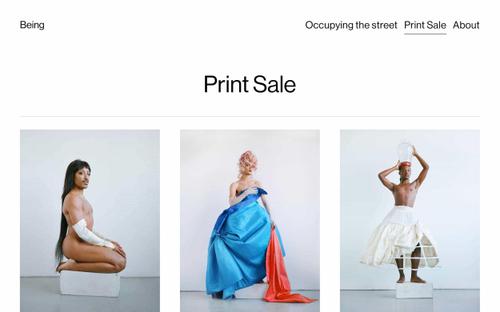Discover and grow your audience with the checklists in our free guide.
The email you entered is invalid.
Thank you for subscribing.
By entering your email, you indicate that you have read and understood our Privacy Policy and agree to receive marketing from Squarespace.
Quick response (QR) codes are everywhere, from restaurant menus to highway billboards, allowing anyone to instantly access websites, marketing campaigns, and various types of content with their mobile device’s camera.
Whether you’re a content creator, freelancer with a growing portfolio, small business owner, nonprofit, or service provider, a QR code is an ideal tool for driving traffic to your most important website pages.
This overview will guide you through best practices and creative QR code approaches for your business and projects, and the Squarespace QR code generator process.
What are QR codes?
A QR code is a type of barcode that’s scannable by a mobile device. Because QR codes are two-dimensional, unlike traditional barcodes, they can store more data, like URLs, images, or contact details.
In 1994, Masahiro Hara, a chief engineer at the Japanese automotive company Denso Wave, invented QR codes to track parts as they moved through the assembly process. These allowed for more flexibility and wider tracking capabilities. QR codes soon became popular in marketing and retail, and received widespread public adoption in 2002 when new scanning apps allowed anyone with a smartphone to use them.
While QR codes have come in and out of popularity, over the past few years, they have become a staple of every brand’s toolkit.
How QR codes can benefit your brand or business
Creating a QR code for your website offers numerous benefits, including gathering engagement data and helping your customers engage with landing pages or campaigns without having to type a URL or click a link. Here are some of the most immediate ways QR codes can help:
Efficiency and time-savings: QR codes help customers to quickly access a landing page with limited manual effort.
Highlighting important or timely information: QR codes can direct customers to what’s most important at any given time, like a menu, payment link, or contact form.
Tracking: Like custom tracking URLs, QR codes let you monitor usage and get information about customer interactions, helping you improve your product and website user experience.
Common uses for QR codes
QR codes have many uses. You can place them almost anywhere to engage customers and the general public. Once you decide where you want to use them, ensure you have a clear vision of how to do so and what your goals are. Here are some common uses:
Link to your portfolio. Whether you’re a photographer, writer, marketing agency, or global brand, QR codes can be a great and effective way to point potential clients to your work.
Link to contact info or email signup. QR codes can help you gather leads, one of the most valuable paths to creating new customers for your business. This can be effective at trade shows, fundraisers, or other in-person events. You can add a QR code to business cards, stickers, or postcards to quickly engage potential customers on the fly.
Access a menu or online ordering page. Many restaurants have a QR code to help customers browse a menu on their website and quickly place an order. It’s an effective tool for serving customers more efficiently, and it’s great for delivery or takeout orders.
Link to a donation page. If you’re hosting a fundraiser, a QR code can help donors get the information they need about your cause. Or you can point it to your donation page so they can easily support your cause.
Connect to a form or booking/reservations page. Like an email signup or contact info link, QR codes are perfect for directing people to fill out a form or book a reservation without trying to sift through links and pages on your website.
Simplify review and testimonial requests. Creating a QR code that directly leads to a testimonial page simplifies the process and will likely get you more reviews.
Enable payments and coupons. Instead of relying on customers to remember a coupon code or payment link, use a QR code to send them right to it.
Where to place a QR code
You can place a QR code almost anywhere to help customers, friends, or colleagues access a website on the go. Business cards, event signage, marketing brochures, stickers, and flyers are just a few of the most common places you’ll see them. Consider whether any of these make sense for your brand.
Business cards: Whether you’re creating a printed or digital business card, adding a QR code can help you easily connect with potential customers or clients.
Stickers: Add a QR code to a sticker as marketing swag, fun gifts, or for local marketing.
Trade show and event signage: A QR code in place of a long URL can help keep signage professional and encourage more visits.
Marketing brochures and flyers: This helps you link to additional information you might not have space for on a brochure, often acting as a second brochure, supplemental material, or digital extension of your printed materials.
Create a QR code on your Squarespace website in 5 steps
Creating a QR code for your Squarespace website is a straightforward process. You can do it for most pages using the following steps. Note: There are a few page styles that don’t have QR functionality yet.
Open the Pages panel in your website account and find the page you want to link to.
Click the gear icon to open the Settings for that page.
In the General tab, turn on the toggle next to QR Code.
You’ll get an automatically generated QR code. Click Download QR code.
Test the code with your own mobile device to ensure it works as expected.
Customize your QR or add it to any materials as you like.
Once you’ve created your QR code, it’s easy to update or delete whenever you need to.
See our complete guide to creating a website QR
Design QR codes for readability
Once you download your QR code, it’s essential to follow a few general design principles so users can access your materials. Whether you’re printing it or displaying it on a screen, these will ensure it’s easy to read and scan.
Keep the contrast high. Use high contrast between the code and the background you choose. Faded or low-contrast graphics may not render properly. Always print a sample to test how well it scans. If the printing is blurry or pixelated, try creating a higher resolution image.
Size it right. Squarespace QR codes will download as resizable PNG files, allowing you to make them as small or large as you like. Make sure it’s at least 2cm x 2cm to scan properly.
Let it breathe. A good, readable QR code should have some negative space around it, often referred to as a quiet zone, to ensure it doesn’t get confused with nearby graphics.
Use a high-quality printer. If you’re printing the code on stickers, brochures, postcards, signage, or anywhere else, work with a good printer to ensure readability.
Ways to personalize your QR code
As long as you follow the above design principles, you can get creative to excite customers and draw their attention to your QR code. Here are a few ideas:
Brand it. Put your brand’s spin on the design to create a clear relationship between the code and you. That could be a slogan or tagline, or logo that’s consistent with your website and marketing materials.
Include a CTA. Like any great marketing materials, a clear call to action will encourage customers to scan your QR code. This can be as basic as “scan here” or something more specific to the page, such as “scan to sign up,” “check out my portfolio,” or “fill out the survey.”
Use some color. While black and white QR codes are effective, adding color can draw attention to them and help maintain brand consistency. Just remember to keep the contrast high and test anything you change up.



